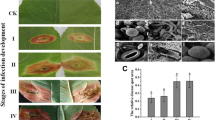Abstract
Except for buckwheat, no cereal or pseudocereal contains any detectable rutin. This study was carried out to compare the rutin content in leaves treated with various concentrations of salicylic acid (SA) (50 mg l−1, 100 mg l−1, 150 mg l−1) for various lengths of time (2–120 h) to those of untreated F. tartaricum. Rutin content in leaves during the early stages of SA treatment (100 mg l−1, 150 mg l−1; 24–48 h) were higher than at other times. The highest rutin content (40.3 mg gFW−1) was found in leaves treated with 150 mg l−1 SA for 48 h. We cloned partial cDNAs of five genes known to be related to rutin biosynthesis from the leaves of F. tataricum using RACE. These genes were chalcone synthase (FtCHS), flavonol synthase (FtFLS-like), flavone 3-hydroxylase (FtF3H), 4-coumaroyl CoA ligase (Ft4CL), and 4-coumaroyl CoA ligase 2 (Ft4CL2). The protein sequences of these genes were analyzed by similarity searching and phylogenetic trees. Apart from the FtFLS-like gene, which had poor identity with F. esculentum, the other genes showed high similarity to those in F. esculentum. During the early stages of SA treatment (24–48 h), expression levels of four genes (FtCHS, FtFLS-like, FtF3H, and Ft4CL) were higher than controls but that of Ft4CL2 was not. Most notably, the expression level of FtFLS-like 24 h after application of 150 mg l−1 SA was 14.79 times of the control. These results suggest that rutin content can be enhanced to great extent by SA treatment and the gene expression patterns of rutin-biosynthesis-related genes are regulated by SA.






Similar content being viewed by others
References
Chen P, Gu J (2011) A rapid measurement of rutin-degrading enzyme activity in extract of tartary buckwheat seeds. Food Bioprod Process 89:81–85
Ehlting J, Büttner D, Wang Q, Douglas CJ, Somssich IE, Kombrink E (1999) Three 4-coumarate: coenzyme A ligases in Arabidopsis thaliana represent two evolutionarily divergent classes inangiosperms. Plant J 19:9–20
Fan BY, Hai L, Jiang XN (2007) High-level expression of 4-coumarate: coenzyme A ligase gene Pt4CL1 of Populus tomentosa in E. coli. For Stud China 9:208–212
Jiang P, Burczynski F, Campbell C, Pierce G, Austria JA, Briggs CJ (2007) Rutin and flavonoid contents in three buckwheat species Fagopyrum esculentum, F. tataricum, and F. homotropicum and their protective effects against lipid peroxidation. Food Res Int 40:356–364
Kim HJ, Park KJ, Lim JH (2011) Metabolomic analysis of phenolic compounds in buckwheat (Fagopyrum esculentum M.) sprouts treated with methyl jasmonate. J Agric Food Chem 59:5707–5713
Kleindt CK, Stracke R, Frank M, Weisshaar B (2010) Expression analysis of flavonoid biosynthesis genes during Arabidopsis thaliana silique and seed development with a primary focus on the proanthocyanidin biosynthetic pathway. BMC Res Notes 3:255–266
Kreft S, Knapp M, Kreft I (1999) Extraction of rutin from buckwheat (Fagopyrum esculentum Moench) seeds and determination by capillary electrophoresis. J Agric Food Chem 47:4649–4652
Kreft S, Štrukelj B, Gaberscik A, Kreft I (2002) Rutin in buckwheat herbs grown at different UV‐B radiation levels: comparison of two UV spectrophotometric and an HPLC method. J Exp Bot 53:1801–1804
Kreft I, Fabjan N, Yasumoto K (2006) Rutin content in buckwheat (Fagopyrum esculentum Moench) food materials and products. Food Chem 98:508–512
Li XH, Park NII, Xu H, Woo SH, Park CH, Park SU (2010) Differential expression of flavonoid biosynthesis genes and accumulation of phenolic compounds in common buckwheat (Fagopyrum esculentum). J Agric Food Chem 58:12176–12181
Martens S, Mithofer A (2005) Flavones and flavone synthases. Phytochemistry 66:2399–2407
Mehta RG, Murillo G, Naithani R, Peng XJ (2010) Cancer chemoprevention by natural products: how far have we come? Pharm Res 12:950–961
Metraux JP (2002) Recent breakthroughs in the study of salicylic acid biosynthesis. Trends Plant Sci 7(8):332–334
Owens DK, Alerding AB, Crosby KC, Bandara AB, Westwood JH, Winkel BSJ (2008) Functional analysis of a predicted flavonol synthase gene family in Arabidopsis. Plant Physiol 147:1046–1061
Stefan M, Axel M (2005) Flavones and flavone synthases. Phytochemist 66:2399–2407
Suzuki T, Honda Y, Funatsuki W, Nakatsuka K (2002) Purification and characterization of flavonol 3-glucosidase, and its activity during ripening in tartary buckwheat seeds. Plant Sci 163:417–423
Vicente RSM, Plasencia J (2011) Salicylic acid beyond defence: its role in plant growth and development. J Exp Bot 62(10):3321–3338
Winkel-Shirley B (2001) Flavonoid biosynthesis: a colorful model for genetics, biochemistry, cell biology, and biotechnology. Plant Physiol 126:485–493
Acknowledgments
We are grateful to Professor Y. G. Wang and Dr. L. Zhang of Shanxi Agricultural University, China, for help with discussing the manuscript. This work was supported by the Youth Science and Technology Research Funds of Shanxi Province (2011021032-3), the Innovative Funds of Shanxi Agricultural University (2010028), Oversea Researcher Fund (2007064) and NSFC (30570154).
Author information
Authors and Affiliations
Corresponding author
Electronic supplementary material
Below is the link to the electronic supplementary material.
Rights and permissions
About this article
Cite this article
Sun, Z., Hou, S., Yang, W. et al. Exogenous application of salicylic acid enhanced the rutin accumulation and influenced the expression patterns of rutin biosynthesis related genes in Fagopyrum tartaricum Gaertn leaves. Plant Growth Regul 68, 9–15 (2012). https://doi.org/10.1007/s10725-012-9688-0
Received:
Accepted:
Published:
Issue Date:
DOI: https://doi.org/10.1007/s10725-012-9688-0




